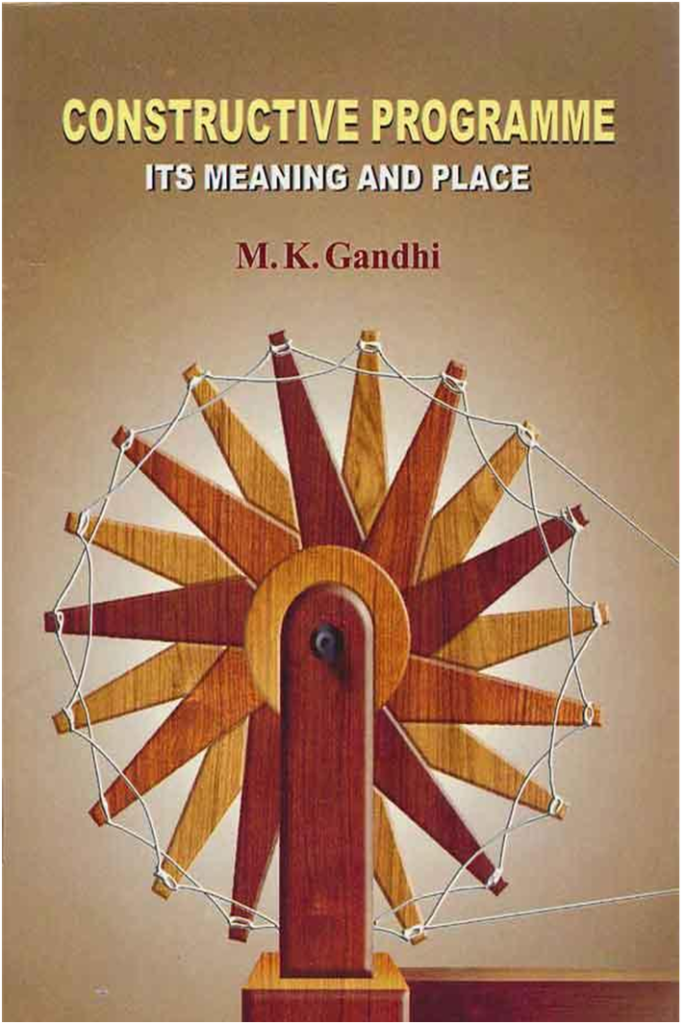
Constructive Program (CP) is a term coined by Mahatma Gandhi to describe one of the two branches of his satyagraha, the other being some form of nonviolence resistance, e.g. civil disobedience, sometimes referred to as “obstructive program”.
CP is a way of carrying out a struggle through community and self-improvement by building structures, systems, processes, and resources that are alternatives to oppression and promote self-sufficiency and unity in the resisting community.
Gandhi used the phrase constructive program to refer to the set of nonviolent, pragmatic actions that together he believed would enable India to achieve economic and political independence.
The program aimed to solve the serious problems that plagued India, such as extreme poverty and discrimination. It represented an evolution of satyagraha in action: from resistance and non-cooperation to performing specific duties through constructive work.
Must read: Factors responsible for the emergence of Gandhiji as an eminent nationalist leader
Gandhi recognized the value of constructive program and used it successfully as early as the first year of his campaigns in South Africa, 1894.
In fact, the value of CP in the struggle for the independence of India cannot be overemphasized, as he described civil disobedience as “an aid to constructive effort.”
Constructive work was the term Gandhi used for the nonviolent activities undertaken to achieve India’s independence. It consists of ordinary people taking accountability for matters that are important to them, yet lacking in their community.
For example, polluted water sources such as rivers were a source of disease in many communities. Constructive work to solve this problem consists of villagers working together to make sure everyone in the community understands the dangers of polluting water, takes precautions to ensure their actions do not contribute to the problem, and works to eliminate existing pollution.
Elements of the Constructive Program
The constructive program evolved over time. Initially comprising four elements in 1919, it grew to eighteen elements by 1945. Even then, Gandhi did not consider it to be exhaustive.
The eighteen elements listed in the version that Gandhi published in 1945 were as follows:
• Communal Unity: Foster solidarity through friendships with followers of other religions.
• Removal of Untouchability: Eliminate idea and customs of untouchability from Hinduism.
• Khadi: Economic self-sufficiency through the production and buying of home-spun cloth.
• Other Village Industries: National support for local products and services.
• Women: Change mindsets, behaviours and laws to reflect the equal status of women.
• Kisans: Support peasants in their nonviolent struggles.
• Labour: Use nonviolent methods for solving all labour disputes.
• Adivasis: Support for the large indigenous population within India.
• Basic or new education: Connect the children of India to all that is best and lasting in India.
• Adult education: Instill self-sufficiency and nonviolence through the constructive program.
• Students: Redefine higher education as service to others through the constructive program.
• Education in Health and Hygiene: Teach people how to achieve health and well being.
• Village Sanitation: Teach people how their communal spaces impact their health.
• Provincial Languages: Use and evolve the many different local languages of India.
• National Language: Use widespread Indian language Hindi for national communication.
• Prohibition: Replace opium and alcohol addiction with healthy and inspiring alternatives.
• Economic Equality: Decrease wealth disparity in India by donating personal wealth to serve
the common good.
• Lepers: Provide care for people suffering from leprosy as a national duty.
Relevance of Constructive Program in Contemporary nonviolent struggles
Contemporary nonviolent struggles often lack constructive program, which could easily be integrated and enable them to be proactive, maintain continuity of effort when direct resistance is not possible, and convince the public and opposition that they are not simply disruptive but have the capacity to build as well.
Most importantly constructive program can build alternative institutions so that a successful insurrection does not lead merely to a power vacuum that lets oppression back in.
External link: https://gandhismriti.gov.in/programmes/constructive-programme
